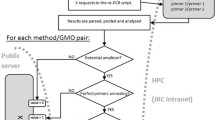Abstract
Legislation in the EU requires that foods containing more than 0.9% of genetically modified organisms (GMOs) should be labelled. To this end, we have developed a simple and accurate capillary electrophoresis multiplex quantitative competitive PCR (ce-mqcPCR) method for event-specific quantification of the five novel GM maize events DAS59122, LY038, MON88017, MIR604 and Event 3272. The method combines the simplicity of constructing multiple competitors in silico with the high resolution and sensitivity of fluorescence capillary electrophoresis and the use of an internal template reference amplicon. The competitors are synthesised commercially and added in equal amounts as a restriction enzyme-digested plasmid insert to the multiplex PCR. Quantification is performed by analysing the relative amounts of GMO and GMO competitor fragment pairs after capillary electrophoresis and correcting for differences in maize DNA by comparing with the internal reference gene amplicon. Since the competitors employ the same primers as their corresponding targets, all existing qualitative multiplex PCRs can in principle easily be converted to quantitative assays without changing primer sets or amplification conditions. The ce-mqcPCR method correctly determined 120 GMO templates in known mixed samples. No false-positive or false-negative signals were obtained.




Similar content being viewed by others
References
James C (2010) ISAAA Brief No. 42
Demeke T, Perry DJ, Scowcroft WR (2006) Can J Plant Sci 86:1–23
Marmiroli N, Maestri E, Gulli M, Malcevschi A, Peano C, Bordoni R, De Bellis G (2008) Anal Bioanal Chem 392:369–384
Holst-Jensen A (2009) Biotechnol Adv 27:1071–1082
Michelini E, Simoni P, Cevenini L, Mezzanotte L, Roda A (2008) Anal Bioanal Chem 392:355–367
Shrestha HK, Hwu KK, Chang MC (2010) Trends Food Sci Technol 21:442–454
von Götz F (2010) Anal Bioanal Chem 396:1961–1967
Grothaus GD, Bandla M, Currier T, Giroux R, Jenkins GR, Lipp M, Shan GM, Stave JW, Pantella V (2006) J AOAC Int 89:913–928
Querci M, Foti N, Bogni A, Kluga L, Broll H, Van den Eede G (2009) Food Anal Meth 2:325–336
Nadal A, Coll A, La Paz JL, Esteve T, Pla M (2006) Electrophoresis 27:3879–3888
Heide BR, Heir E, Holck A (2008) Eur Food Res Technol 227:527–535
Holck A, Pedersen BO, Heir E (2010) Eur Food Res Technol 231:475–483
Leimanis S, Hamels S, Naze F, Mbella GM, Sneyers M, Hochegger R, Broll H, Roth L, Dallmann K, Micsinai A, La Paz JL, Pla M, Brunen-Nieweler C, Papazova N, Taverniers I, Hess N, Kirschneit B, Bertheau Y, Audeon C, Laval V, Busch U, Pecoraro S, Neumann K, Rosel S, van Dijk J, Kok E, Bellocchi G, Foti N, Mazzara M, Moens W, Remacle J, Van Den Eede G (2008) Eur Food Res Technol 227:1621–1632
Bahrdt C, Krech AB, Wurz A, Wulff D (2010) Anal Bioanal Chem 396:2103–2112
Holck AL, Drømtorp SM, Heir E (2009) Eur Food Res Technol 230:185–194
Heide BR, Drømtorp SM, Rudi K, Heir E, Holck A (2008) Eur Food Res Technol 227:1125–1137
Rudi K, Rud I, Holck A (2003) Nucl Acids Res 31:e62
Kalogianni DP, Elenis DS, Christopoulos TK, Loannou PC (2007) Anal Chem 79:6655–6661
Studer E, Rhyner C, Luthy J, Hubner P (1998) Z Lebensm Unters Forsch 207:207–213
Hardegger M, Brodmann P, Herrmann A (1999) Eur Food Res Technol 209:83–87
Garcia-Canas V, Cifuentes A, Gonzalez R (2004) Anal Chem 76:2306–2313
Bustin SA (2002) J Mol Endocrinol 29:23–29
Dufva M (2005) BioTechniques 39:484–484
Dong W, Yang LT, Shen KL, Kim B, Kleter GA, Marvin HJP, Guo R, Liang WQ, Zhang DB (2008) BMC Bioinform 9:260–267
Raeymaekers L (1995) Genome Res 5:91–94
Anon (2006) Appl note Taqman gene expression assays:1–6
Bustin SA, Benes V, Garson JA, Hellemans J, Huggett J, Kubista M, Mueller R, Nolan T, Pfaffl MW, Shipley GL, Vandesompele J, Wittwer CT (2009) Clin Chem 55:611–622
Holst-Jensen A, Rønning SB, Løvseth A, Berdal KG (2003) Anal Bioanal Chem 375:985–993
Delseny M, Glaszmann JC (1995) Biofutur 146:52–56
Akiyama H, Watanabe T, Wakabayashi K, Nakade S, Yasui S, Sakata K, Chiba R, Spiegelhalter F, Hino A, Maitani T (2005) Anal Chem 77:7421–7428
Acknowledgments
We thank Dr. P. Lea, Nofima AS, Norway, for statistical analyses. The authors declare that they have no conflict of interest. This work was supported by the Norwegian Research Council project 154254/130 and the European Commission through the Integrated Project Co-Extra, Contract No. 007158, under the 6th Framework Programme, priority 5, food quality and safety.
Author information
Authors and Affiliations
Corresponding author
Rights and permissions
About this article
Cite this article
Holck, A.L., Pedersen, B.O. Simple, sensitive, accurate multiplex quantitative competitive PCR with capillary electrophoresis detection for the determination of genetically modified maize. Eur Food Res Technol 233, 951–961 (2011). https://doi.org/10.1007/s00217-011-1594-6
Received:
Revised:
Accepted:
Published:
Issue Date:
DOI: https://doi.org/10.1007/s00217-011-1594-6




